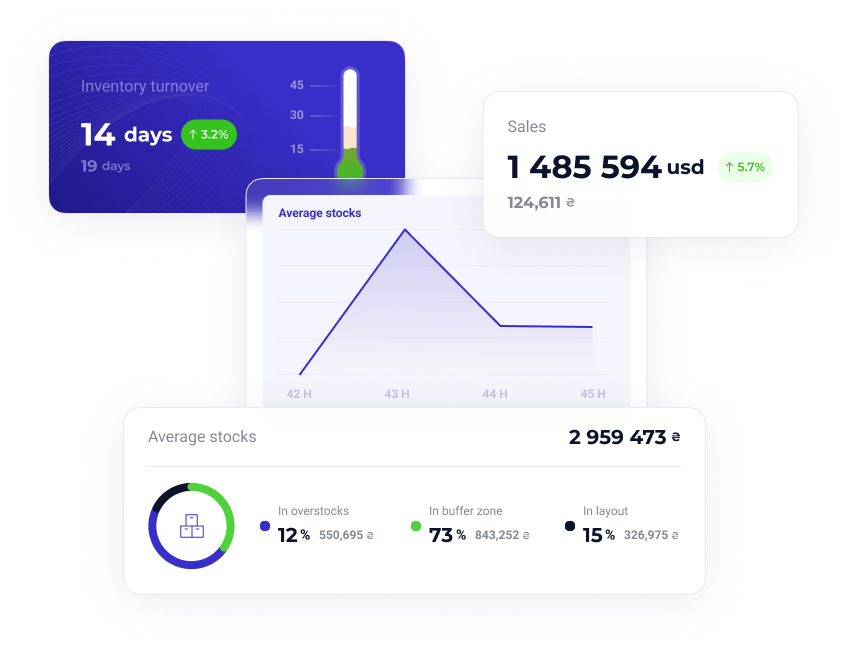Effects of ABM Inventory Implementation
Turn the autopilot on in your store and warehouse inventory management and increase your turnover and profitability.



Whatever the size or industry, we can help

Food & Beverages

Health & Beauty

Toy stores

DIY

Pet stores

Pharmacies

Auto parts

Electronics

Liquor stores
ABM Inventory System: features
Dashboard
Demand forecasting
Automatic replenishment
Fresh category management
Multi-echelon inventory optimization
Multi-scenario seasonal planning
Promotion planning and execution
Analytical BI module
Automation of assortment rotation

-
Operational
Up-to-date task lists and specific indicators that show surplus or lost sales and changes on a daily basis. If the dynamic turns negative, the system generates an additional report that helps you to understand the reason for the development.
-
Strategic
Comprehensive analysis of stocks, sales, availability, and turnover as well as their dynamics, system efficiency, and the accuracy of the generated orders.
-
Insights
An analytical overview of the inventory structure that allows you to focus on problem areas that could seriously impact the business.

-
Strategic decision making
Precise ML-based forecasting allows you to make informed decisions regarding assortment expansion, opening of new stores, planning annual budgets, and KPIs.
-
Determine the level of influence for each demand factor
The system takes into account only statistically significant factors, omitting negligible factors that reduce the accuracy of the forecast.
-
Forecasting based on business specifics
Depending on the specific requirements, the system builds a forecast using one of 3 forecasting models.
-
Assortment management tailored to customer preferences
Your customers will know that they will always find the right product at an affordable price. And you will be sure that they will come back to you.
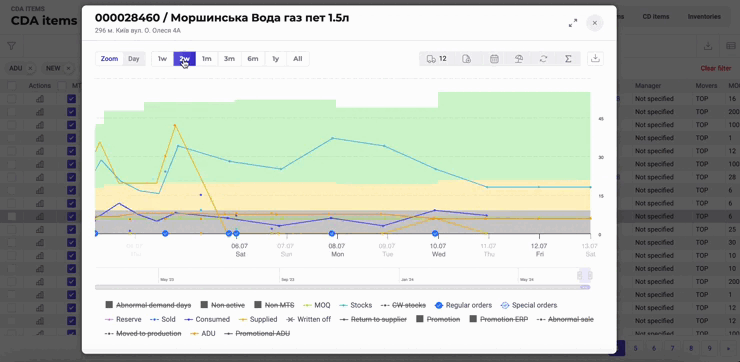
-
Calculation of the required quantity of goods
Taking into account the demand for each SKU at each point of sale and analyzing the available balance and goods in transit.
-
Formation and dispatch of orders
Every day, after calculating the demand, orders are automatically generated based on the assortment matrices and schedules. Then the orders are automatically sent to the user's system and suppliers.
-
Automatic editing and control of order fulfillment
Allows the supplier to edit the quantity of goods after receiving the order, automatically updating the information in the sent orders and track the delivery time of the order, sending a notification to the manager in case of delay and recording information about the delay in the analytical report.

-
All key factors are taken into account:
Demand forecast, order fulfillment time, packaging and supplier restrictions, demand volatility, available stocks.
-
Remaining shelf life and weekday-related demand variations are accounted for
-
A simplified analogue of LIFO batch accounting
-
Required availability level:
Set an acceptable level of availability for each item to avoid write-offs.
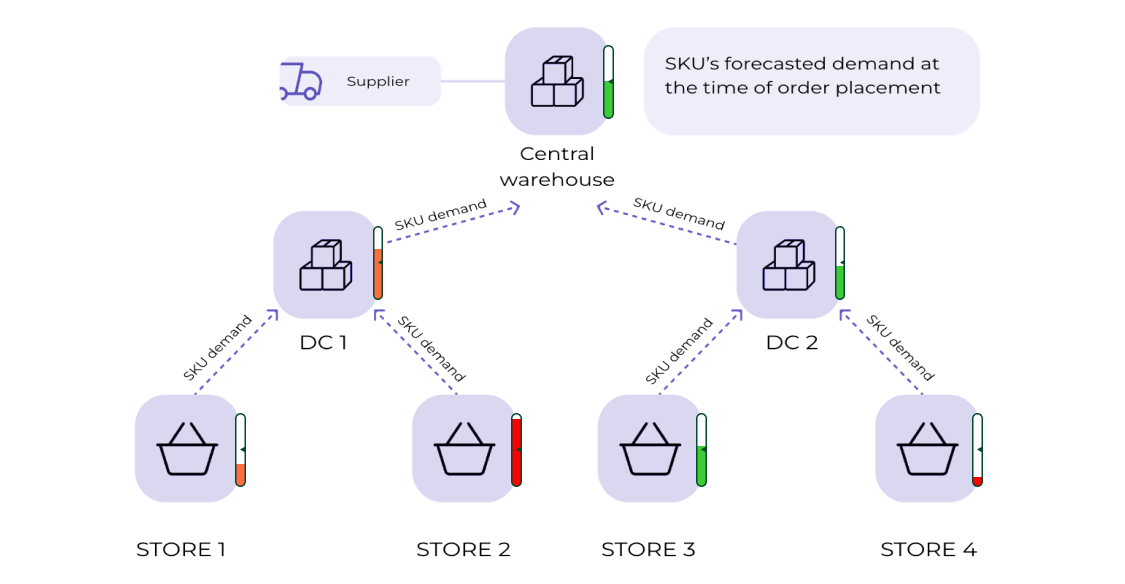
-
Ensure inventory balances
Transparent, unified inventory management process at all levels of the supply chain due to the close connection between supply and demand of goods.
-
The system takes into account various business supply processes:
Classic warehouse storage, cross-docking, pick by line, pick to zero.
-
Flexible settings
The flexibility of the algorithm is such that you can include all the necessary factors and features of delivery.
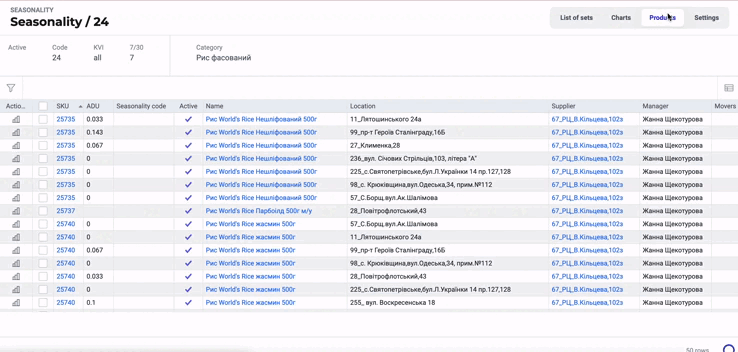
-
Automatic calculation and application of seasonality coefficients
The software factors in demand fluctuations for a regular assortment, seasonal goods, and those that are available only for a limited time, too.
-
A set of different scenarios
Different scenarios are applied depending on the market situation.
-
Quick analysis due to high-quality visualization

-
Sales forecasting and preparation for promotional activities
The forecast is generated with the help of ML models that consider various factors affecting the demand for promotional products.
-
Flexible response to actual demand during the promo period
The system analyzes sales and demand, recalculating the required inventory level for each store, which allows you to strike the balance between high product availability and minimal overstocks across all outlets.
-
Promo performance analysis
Quickly assess the promotion’s effectiveness by evaluating the plan/fact numbers, balances, turnover, product availability level, and sales lost during the campaign.

-
A flexible BI tool based on the Qlik Sense platform
-
40+ reports to analyze the efficiency of inventory management
These include ABC(D) + XYZ assortment analytics, inventory availability and turnover, reasons for lost sales, supplier service level, effectiveness of promotional activities, analysis of overstocks, and many other reports.

-
Demand forecasting for new products
The system automatically forecasts demand and generates the first order based on historical sales data for analogs, substitutes, or groups of products with similar characteristics.
-
Withdrawal of an item from the assortment
The status of goods at different levels of the supply chain automatically changes based on the balances.
We appreciate that you are interested in our products. One of our employees will contact you shortly. Good day!
The implementation stages
01 Express diagnostic
02 Business processes audit
03 Implementation
Express diagnostic
Business processes audit
Agreeing on the project charter
Database integration
Pilot Launch
Scaling
Advantages of working with us

We are always by your side
We guarantee support, assistance and consultations at all stages of our cooperation.
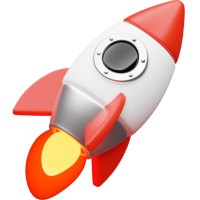
Continuous Improvement
We actively implement innovations in the system and respond to our clients' suggestions.

Proven Track Record
With over 1000 successful implementations, we have earned our clients' trust.
FAQ
How does the system order fresh and ultra-fresh?
The system takes into account the remaining shelf life and allows you to set up LIFO batch accounting. It monitors the valid carryover balance and predicts potential write-offs. There is also a shortage management scheme that allows you to sell goods with a zero balance for delivery as much as possible.
Does the system take into account expiration dates?
Yes, the system takes into account the remaining shelf life.
The system takes into account the statistics of historical periods. For what period?
The system takes into account the history for the last 3 years.
Does the central office or stores make orders?
Usually, 95% of the assortment is determined by the central office, and stores can influence the adjustment of orders only for ultra-fresh products.
How long does it take to implement?
It really depends on the maturity of the company, the availability of established business processes, and the correctness of the data on balances.
Do you have experience working with companies that have a lot of problems with balances?
Yes, we have an algorithm that calculates the need based solely on sales and receipts. The project usually lasts 5-7 months.
Learn more about automated inventory management system

How a Retailer Increased Bakery Sales by 26% – A Practical Inventory Automation Case

Effective Management of Promotional Products: A Case Study on Avoiding Excess and Shortage

Optimization of Dairy Inventory: A Real Case of Reducing Surpluses and Increasing Sales

How to define the Economic Order Quantity. Success story retail

Automated Ordering of Goods
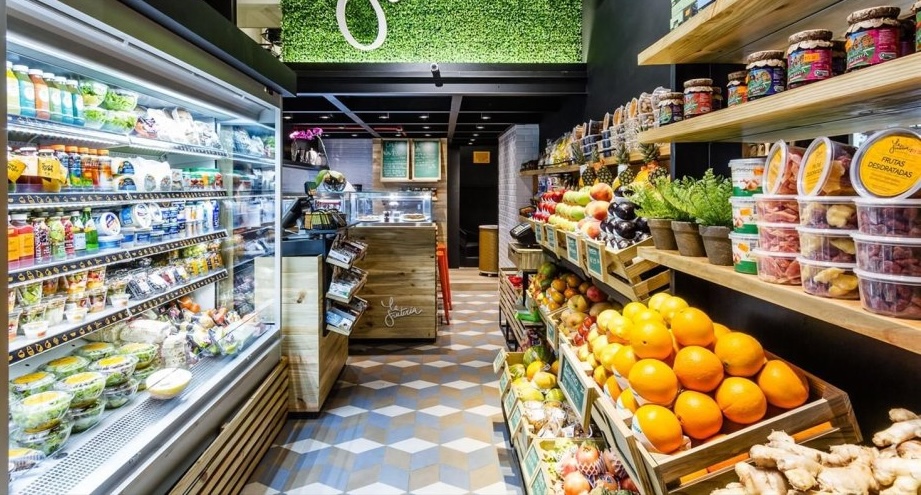
Inventory Management in Retail: How to Calculate Key Performance Indicators
We appreciate you contacting us. One of our specialists will get back in touch with you soon. Have a great day!
